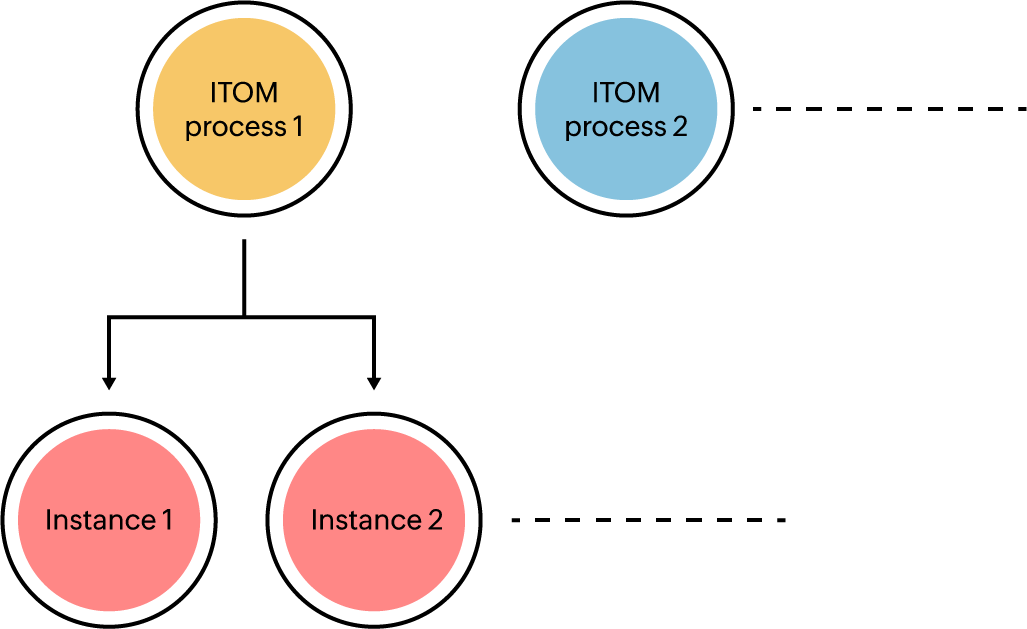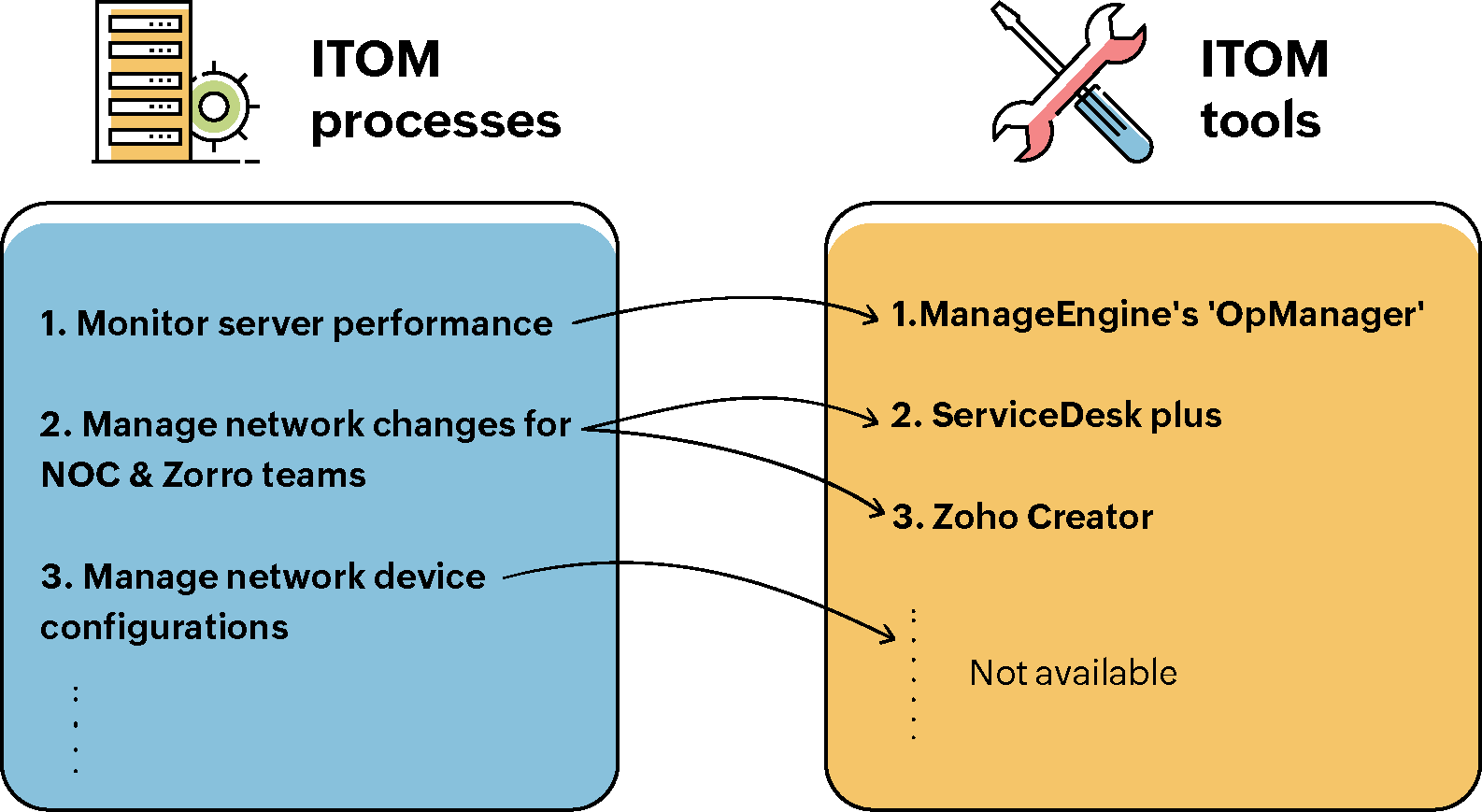How to get started
1. Create process narratives
Process narratives describe how your ITOM processes function in full detail. We create process narratives by following two steps:
- Make a list of all your ITOM processes and store it in a central location.
- Every time you perform an IT operation, document the instance and attach it to the parent process.

Scenario 1
You must check a core switch for a particular configuration. The first time you do it, it takes two days. What is the acceptable amount of time when you have to do it again?
ITOM process: The ITOM process here is checking a core switch. The process narrative must have a well-documented procedure for this process. For more information on how you can nail your documentation efforts, refer to this section in our e-book, A CIO's guide to rethinking compliance.
The core ITOM procedure for checking a core switch must be elaborated with enough diagrams to explain it to an engineer. Let us now analyze instances for this process.
Instance 1: Instance 1 could have taken place on a particular day with a certain objective. Maybe it had to do with a specific type of inbound access. This instance will be recorded with the date, objective, challenges faced, and solutions implemented.
Instance 2: This instance could have taken place six months later for a type of outbound access. This instance will be recorded the same way as instance 1.
There could be any number of instances, and each will provide some deeper insight into the process. The next time an engineer wants to check a core switch, these instance-based documents will save them time by telling them exactly what access needs to be allocated based on the situation. Let us take a look at another scenario.
Scenario 2
An experienced engineer can create a new set of firewall rules with ease. Will a new team member be able to do it as easily as the experienced engineer?
ITOM process: The ITOM process narrative will have all the details about the firewalls in the company, including how all the DCs will likely have the same firewall model or vendor. When creating new firewall access, the process narrative will explain how to log in, provide incoming to outgoing access for users, create addresses, create roles for people, add it to the policy, and finally enable it. There are different sets of checklists for different variations of this process.
If the base ITOM process narrative is created end-to-end like above, a new member on the ITOM team will be able to replicate the process easily. As they document their instances, they will get better with experience and improve the process itself over time.

ITOM process checklists
You can use the following checklist for network operations:
- An overview: Determine the scope of the NOC team, where it operates from, who is responsible for major decisions, and the list of DCs and corporate offices.
- Access controls: Establish physical and logical access controls to define access to physical spaces and to various tools used by the NOC team, respectively.
- Asset and inventory management: Maintain a list of all the available network devices (switches, routers, firewall devices, and their components). Document the process of who purchases network assets and how the return of assets is handled.
- Network monitoring: List the procedures for monitoring the various parameters of switches, firewalls, and routers along with the required tools and the people involved.
- Backup management: Make adequate backups of network configurations on a daily and weekly basis. You can include clauses for these in your network policy.
- Change management: List the detailed procedures for all types of changes, like general changes (device additions, replacements, upgrades, provisioning, and configuration changes), VLAN changes, and firewall rule changes. Include details like tools, approvals, and responsibilities for each type of change.
- Planned maintenance: This will be necessary when you make major device or configuration changes. Document the process with details like who requests the maintenance, who approves it, and what criteria they use to approve it.
- Incident management: Your team must collaborate with the incident management team to resolve incidents quickly. List the various types of incidents (security, availability, and privacy) and describe how each of them will be resolved by involving your team.
- Access to your VPN: Determine how access to your VPN is provided and who monitors it.
- Vulnerability management: Outline the role of the NOC team in assisting the information security team to implement fixes for vulnerabilities.
- References: Documents concerning the network policy, roles and responsibilities, and links to applications used by the NOC team should be made available in a database for reference.
For processes involving DCs, you can additionally include these sections:
- Server procurement: Elaborate on the process of how servers will be purchased and who makes decisions.
- Additional access controls for DCs: Define the physical, logical, and enhanced data security controls for entry into your DCs.
- Availability: List your availability goals and explain how you will achieve them.
- A business continuity plan: Explain how you plan to keep the business running during emergencies or disasters.
- OS patch management: Explain in detail the procedure for running patches along with safety measures, alternatives, and approvals.
2. Analyze gaps in ITOM capabilities
Analyzing gaps in your ITOM capabilities will help you discover where you lack the crucial tools to improve your ITOM processes. Starting with the process narratives, you can create a map of ITOM processes and the ITOM tools available for them.
Let us consider the following major categories of ITOM processes we discussed earlier:
- Tools for monitoring traffic
- Tools for managing device configurations
- Tools for analyzing logs
- Tools for other operational activities
Here is what a map of processes vs. tools could look like for you:

In the above example, you might have ManageEngine OpManager for monitoring servers and multiple tools for managing network changes. However, you might not have a dedicated tool for managing network configurations.
If you extend the above map to all your ITOM processes, you will be able to understand the gaps in your ITOM capabilities. This analysis will help you make decisions on how you can quickly fill those gaps.
3. Craft an ITOM policy
Once you are aware of your processes and ITOM capabilities, an ITOM policy will help you merge both to create a well-structured ITOM framework for your company. An ITOM policy is a set of statements conveying your organization's position on some key areas. A policy is also a reflection of your company's values and a guide on how your IT teams make decisions.
To create a strong ITOM policy, you can answer a few important questions relating to your IT teams. The answers to these questions will turn into your ITOM policy.
|
|
Policy question |
Possible policy statements |
|
1 |
On what basis will you provide access to various IT environments? |
"All LAN to WAN access attempts will be denied by default, and access will only be provided based on the approval process." "The internal VLAN will be accessible by default within the LAN, and ACLs will be written based on the approval process for special VLAN restriction cases." "NOC engineers, senior NOC engineers, project coordinators, and the NOC director will have admin access to network devices." |
|
2 |
What aspects of your ITOM environment will be monitored? |
"The network capacity and configuration shall be monitored biweekly by the level three technicians." "Firewall logs will be centralized and monitored every day." |
|
3 |
How will you manage your network and DC components? |
"The asset inventory shall be maintained and managed solely by the NOC team." "All DCs and corporate networks shall be managed from the NOC." "All network devices shall be managed by the NOC director and the senior NOC engineers." |
|
4 |
What will be your objective? |
"The NOC team's main priority will be to maintain high availability of 99.9% monthly uptime for cloud services." "Zorro's objective will be to handle DC operations by providing the required assets and addressing and mitigating risks." |
|
5 |
How will you handle changes? |
You must draft a change management policy that answers questions like:
|
The above list of questions is not exhaustive. You can add any number of questions that matter to your IT teams and management. Over time, and with experience, these policy statements are bound to become refined and provide better direction to your IT teams.
Conclusion
Growth is always accompanied by challenges and, as a result, changes. We have reflected on ManageEngine's journey and examined our ITOM framework through this e-book. As we evolve, our ITOM capabilities will expand, and we will take on more challenges. If history is any indication, we will convert those challenges into solutions for our customers' problems.
Since we also use our own tools to run our organization, we will make progress in terms of our frameworks and tools in the years to come. Perhaps we will create a new and improved edition of this e-book? Until then, you can use this version to reflect upon your own ITOM framework and capabilities.
Glossary of tools
Tool type |
Capabilities |
Tool used by ManageEngine |
|
Overall management |
Acts as an admin console for managing inventory, server allocation, provisioning, load balancer configuration, disaster recovery switching, and more |
ZAC: An in-house tool developed by ManageEngine |
|
Log analysis |
Provides event log and syslog management, alerts, application log auditing, IT compliance, and more |
|
|
Interface monitoring |
Analyzes the performance of networks, generates reports on network performance, and more |
|
|
Configuration management |
Makes automated backups, automates routine network management tasks, facilitates network changes, and more |
|
|
Monitoring instrumentation |
Provides visibility into the entire network, monitors network devices (switches, firewalls, and routers), offers dashboards to aid decision-making, and more |
MI tool: An in-house tool developed by ManageEngine |
|
Firewall management |
Monitors firewall logs, generates custom network security reports, and more |
|
|
Other operations |
Custom forms for managing operations |
|
|
A service desk for support |
||
|
Tools for maintaining documents |
||
|
Password management |